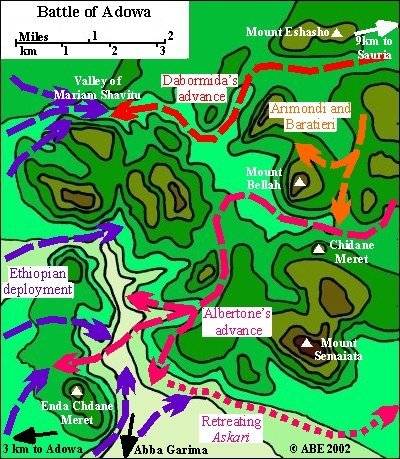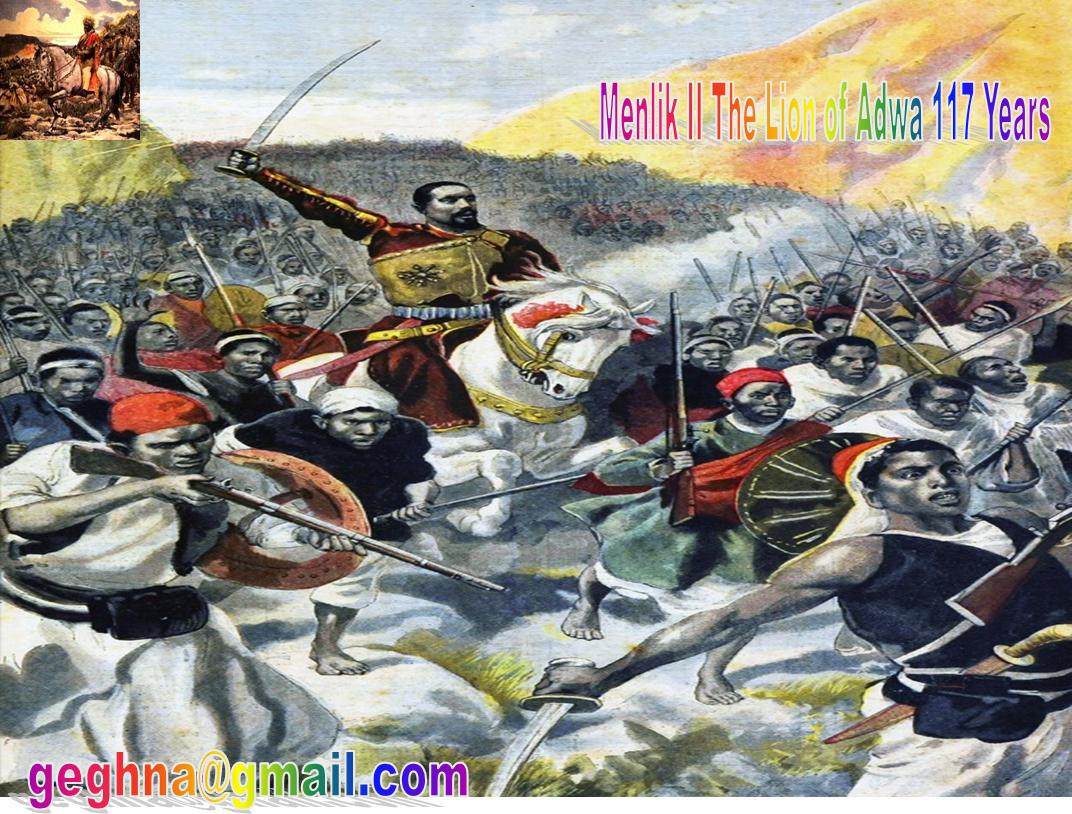The battle of Adwa of March first of March, 1896 a great victory and pride for Africans at home and Diaspora. The victory assured that Ethiopia successfully resists European colonization.
Italy the late comer to the scramble for Africa in the late 19th century was allocated to Ethiopia but just needed to take control. The Italians and the rest of the European powers present at the Berlin Conference 1880’s wrongly assumed that Ethiopia was made up of rival tribes fighting one another and thought it would be a quick promenade for their 20,000 strong highly trained invasion forces. They never thought what they call “tribal back word savages” could be united raising a much larger patriotic people’s army to defend their country and even to win an all out war.
[media id=492 width=520 height=440]

The main cause of the Battle being the European colonial ambition it manifested through the deferent treaty the colonial powers used to cheat the Africans. This was highly manifested by Italo Ethiopian Treaty known as the Wechale Treaty. The colonial manipulation started when Menelik II came to the throne in 1889 the Italians thought that he would surrender sovereignty to them since they had been supplying him with ammunitions. They succeeded to manipulate the king on May 2, 1889, to make him sign the Treaty of Uccialli in the province of Wello, with which Menelik accorded for the Italians some land in Tigre to the already concession he has made by letting them to take Eritrea. In this famous once sided treaty, they tricked Menelik by having two different versions- one in Italian and other in Amharic. The secret of the Italian plan was manifested on article 17 which read in one in Amharic and other in Italian. Thus the Italian version read: –
“The Emperor consents to use the Italian government for all the business he does with all the other Powers or Governments“.
The Amharic version reads:-
“The Emperor has the option to communicate with the help of the Italian government for all matters that he wants with the kings of Europe.”
—————————–
When Menelik realized that he had been cheated he immediately rejected the treaty and refused all further offers of gifts from the Italians. Turkey, Russia and France stood to the Ethiopian version of the story. Finally Menelik decided to confront the advancing Italian Army which has already occupied Tigre Provence without his contentment.
As a result in September of 1895, Menelik, King of Kings of Ethiopia mobilized the population of Ethiopia to arms. Over 100,000 Ethiopians gathered under his rank to liberate his occupy province by the Italian forces.
———–——–
“God, in his bounty, has struck down my enemies and enlarged my empire and preserved me to this day. I have reigned by the grace of God….Enemies have come who would ruin our country and change our religion. They have passed beyond the sea which God gave us as our frontier….These enemies have advanced, burrowing into the country like moles. With God’s help I will get rid of them.”
Menelik divided his Army under three leaders:-
- Emperor Menelik II, The King of Kings of Ethiopia
- Empress Taytu Betul, The Wife of Menlik II
- Negus Tekle Haymanot Tessemma ,
- Ras Welle Betul ;
- RasMengesha Atikem ;
- Ras Mengesha Yohannes ;
- Ras Alula Engida ;
- Ras Mikael of Wollo;
- Ras Makonnen Wolde Mikael;
- FitawrariGebeyyehu,
[stream provider=youtube flv=http%3A//www.youtube.com/watch%3Fv%3DYdEifBqlcvI img=x:/img.youtube.com/vi/YdEifBqlcvI/0.jpg embed=false share=false width=340 height=260 dock=true controlbar=over bandwidth=high autostart=false /]
On the night of 29 February and the early morning of 1 March three Italian brigades advanced separately towards Adwa over narrow mountain tracks, while a fourth remained camped. The Italiano Forces were led by:-
- General Oreste Baratieri ;
- Brgdaire Matteo Albertone,
- Giuseppe Arimondi,
- Giuseppe Ellena and
- Vittorio Dabormida.
[media id=490 width=520 height=440]
These invading Italian forces were made up of 18,000 infantry and 56 artillery guns, and with many thousands of Eritrean militias were prepared to fight against Menelik II on the battle field.
At 6:00 on the 1st of March 1896 the Italian Gen. Albertone used the Eritrean askari peasant fighters to face their brother Ethiopian as is always the game to make the enemy to kill one another at a place called Kidane Meret. This was the hill where the Ethiopians had managed to set up their mountain out front. On the hill side though outnumbered by the Eritrean askaris, the Ethiopian fighters were able to hold their position for two hours which they broke the rank of the Italians and able to capture General Albertone’s. At such heroic fight the Italian and their remaining askaris dispersed leaving the wounded and the dead. Seeing the capture of the Albertone Gen Arimondi’s brigade joined the fight at the last minute and start punching the Ethiopians to liberate the captured Italians. The Ethiopians fought courageously and battled the colonizers three hours while Menelik himself joined the combat with his 25,000 strong Shewans people’s army and broke their back bones once for good. Brigadier Dabormida now made a fatal error as he retreated from Menelik’s push, he was cornered into a narrow hill where he was ransacked by Ras Mikael ‘s Oromo Army . They wiped him out, his body was never recovered. The last blow came at noon the next day when Negus Tekle Haymonot led his Gojjam forces break the back bone of the remaining Italian brigade. This happened when Negus was attacked by the last of the invading army which he destroyed and by one o’clock the battle was finished with victory to the African Army.
The battle was bloody over 8,000 Italians died and 1500 wounded many captured fighting hard to save the pride of European colonizers, but with no avail. Almost the same amount of Ethiopians perished in this decisive war of history in the African heartland after the war of the Zulu in South Africa and Mhadist victory against the Britons in Khartoum led by Mahadi.
“In Ethiopia, the military genius of Menelik II was in the best tradition of Piankhi, the great ruler of ancient Egypt and Nubia or ancient Ethiopia, who drove out the Italians in 1896 and maintained the liberties of that ancient free empire of Black men.” Huggins and Jackson analyzed the victory not only in terms of its significance to the postcolonial African world, but also in terms of its linkage to the tradition of ancient African glories and victories. An Introduction to African Civilizations, Huggins and Jackson write
[media id=491 width=520 height=440]

